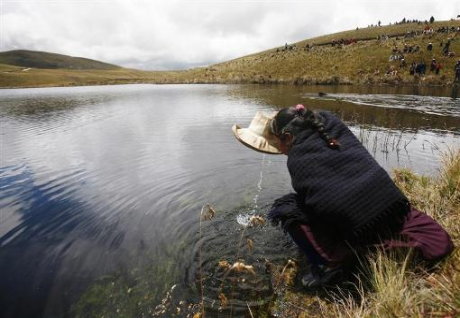Policymakers agree ambitious global water monitoring initiative-expert
Julie Mollins
Sep 5 , 2012

An Andean woman drinks water from the Cortada lagoon in the Andean region of Cajamarca November 24, 2011. REUTERS/Enrique Castro-Mendivil
By Julie Mollins
STOCKHOLM (AlertNet) – Policymakers have agreed an ambitious plan to create a global monitoring and reporting system to oversee water supply, sanitation and water resources management, a U.N. expert said.
Part of the initiative would be assisting developing countries to collect and analyse data on their water resources. The data would likely feed into the Sustainable Development Goals (SDGs) that are expected to replace the U.N. anti-poverty Millennium Development Goals (MDGs) in 2015, Joakim Harlin of the United Nations Development Programme (UNDP) said.
Harlin said UN Water, a body coordinating work done by U.N. agencies, was working on defining a proposed SDG water target to replace the MDG of halving the number of people without sustainable access to safe drinking water and sanitation by 2015.
Harlin said experts were also exploring ways a water goal could link up with other possible SDGs on energy and food.
"We are taking very seriously the cross-cutting nature of water, and that decisions in other sectors impact very much on water," Harlin, UNDP's senior water resources adviser, told AlertNet on the sidelines of the World Water Week conference in Stockholm.
"I'm pretty sure energy will be one of the goals," Harlin said. "I'm sure it must come up because it is such a vital issue for addressing poverty alleviation."
Experts are facing the complex challenge of how to manage pressures on the world's water infrastructure – vital for food and industrial production, drinking supplies and human sanitation – as the global population is projected to rise from 7 billion to more than 9 billion by 2050.
WATER SCARCITY
Already, almost 1 billion people go hungry, 2.5 billion people lack adequate sanitation and about 783 million people lack access to safe water.
Another concern is the trend towards massive land acquisition, fuelled in part by demand for water sources on the land acquired.
The World Bank estimates that more than 56 million hectares of land were leased in 2009, 70 percent of which were in Africa, according to a recent report produced by the Stockholm International Water Institute (SIWI) on Land Acquisitions.
Other statistics suggest that more than 227 million hectares of land -- roughly the size of Western Europe -- have been sold or leased in the developing world over the past 10 years, mainly for growing crops or bio-energy, the report said.
More than 70 percent of the freshwater used in the world each year goes to agriculture.
UN Water is expected to finalise the details of the water monitoring initiative by the end of the year, Harlin said.
The project, led by UNDP and the United Nations Environment Programme (UNEP) and in conjunction with the Global Water Partnership (GWP), aims to set indicators for water resource management.
UN Water hopes by collecting more up-to-date and comprehensive data that it can advise governments on how to manage their precious water resources, Harlin said.
MORE RELEVANT GOALS?
The drinking water MDG goal was met by the end of 2010, according to a joint monitoring programme led by the World Health Organisation (WHO) and the U.N. children's fund (UNICEF), but sanitation targets are off track and likely to be missed.
The new SDG water goal will probably be broader than the current water and sanitation MDG.
"If this water goal is related to water security or water security-sanitation ... we would need to have separate targets and indicators that lead up to that one goal," Harlin said, adding that the goal would include water supply, sanitation, water resources management, and perhaps water efficiency, water quality, groundwater and transboundary water.
Harlin said one of the weaknesses of the current MDGs is that they mask disparities and that results from a few large countries can end up dominating the bigger picture.
A monitoring framework would be an improvement because it would produce more country-specific priorities, he said.
"If you look at the water supply and sanitation targets, India and China alone can almost ensure that we achieve the (MDG) goals," he added.
SUSTAINABLE DEVELOPMENT
It is not yet clear whether the SDGs will be underpinned by the water-food-energy nexus, a concept that urges businesses, governments and civil society to take a more holistic view of economic growth and development.
It aims to create a sustainable economy and a healthy environment by considering the pros and cons of how each of the three elements interrelate and are affected by decision-making.
Some companies are already taking a more sustainable approach to their business operations by trying to reduce their consumption and reinvest in the environment to mitigate their impact.
"Businesses are seeing that there's more competition, that they cannot sustain their business unless ... they are seeking to be more engaged, taking a larger view on things," Harlin said.
"The challenge is how we can construct goals, targets, indicators and monitoring-reporting systems that are realistic, Harlin said."They have to be simple enough to be realistic, but complex enough to give us useful information."
